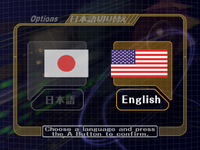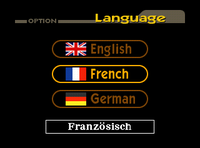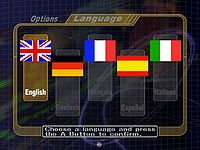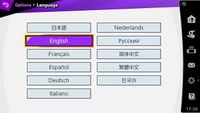Language
Language is an option found in the Options menu on the PAL version of Super Smash Bros., all versions of Super Smash Bros. Melee and Super Smash Bros. Ultimate, and determined by system settings in the PAL version of Super Smash Bros. Brawl and all versions of Super Smash Bros. 4. As the name suggests, the player can adjust the language of their copy of the game.
In Super Smash Bros.
The original Super Smash Bros. is available in five languages: Japanese, English, French, German, and Simplified Chinese.
Language can only be adjusted in the European version of SSB (uniquely, SSB has separate PAL versions for Europe and Australia). The language can be set to English, French, or German through an extra section on the options menu. When the player hovers over a menu item with the language set to either French or German, a white box with its corresponding translation will display at the bottom of the screen. The announcer is dubbed in both languages; however, the German version does not have unique voice clips for "Captain Falcon", "Computer Player" or "Team Battle", using the English clips instead, and the actors and actresses are dubbed in both languages; however, the German version does not have a unique voice clip for "Goldeen", using an English clip instead.
The Simplified Chinese version of the game is only available on the iQue Player, the Chinese export of the Nintendo 64. While the game is fully translated, almost all voice acting is reused from the English version of the game. Jigglypuff and most non-playable Pokémon, however, receive new voice clips.
The Japanese, Chinese, American and Australian versions possess a singular language option.
In Super Smash Bros. Melee
Super Smash Bros. Melee is available in six languages: Japanese, English, French, German, and two languages making their debut: Italian and Spanish. As the game was never officially released in mainland China, Simplified Chinese is unavailable.
NTSC versions
In the NTSC versions of Melee, the player can switch between Japanese and American English for their languages. Changing the languages has little to no effect on actual gameplay; almost all changes in the game are cosmetic when languages are switched.
When the English language setting is active, the "Language" option is written in Japanese. The opposite occurs if Japanese is set as the language instead.
List of differences in the Japanese version versus the American English version
- Bowser and Jigglypuff are given their Japanese names of "Koopa" and "Purin" in Japanese. All Pokémon, when released, will also say their original names depending on the version.
- The Ice Climbers have a caption of "Ice Climber", in the singular; in addition, the announcer refers to them as "Ice Climber" as well.
- Donkey Kong's caption in Japanese is spelled as "D.Kong"; in English, Donkey Kong's caption is "DK".
- The Collection mode will change depending on the language; a list of differences can be seen in the Collection article.
- Trophies will display what console the game was released for in Japanese; this indication doesn't appear in American English. Trophies are also referred to as "Figurines" in Japanese.
- Some characters who are voiced in Japanese in both language settings may or may not speak depending on the language. In American English, Mewtwo and Sheik do not speak, but in Japanese, the two speak in some cases.
- The camera angle in the Home-Run Contest is more zoomed-in when the language is set to Japanese.
- All distances in the game are recorded in feet in American English, due to America's use of the U.S. Imperial System. All distances are recorded in metres in Japanese, as Japan uses the metric system.
- The latter is also the case with the PAL version, as Europe and Australia both use the metric system.
- The announcer says different phrases in some of the game modes, which are covered in the respective article.
- Most crowd chants are different in Japanese than they are in American English (except Mario, Luigi, Donkey Kong, and Young Link).
- The Sound Test features two kanji characters in place of the discs when set to Japanese; these characters also spin when music is played.
- There are various cosmetic changes to the menus. On the Character select screen, for instance, when set to Japanese, the "Ready to Fight!" banner says "Press Start/Pause", while in American English, it will simply say "Press Start".
- The lottery, in Japanese, will say "Get!" and "New Figure". In English, these messages will be replaced by "Got it!" and "A new trophy!" In addition, the Lottery also has a green "A" above the lever when the game is set to Japanese.
- Though the Japanese release has a different design for the Motion-Sensor Bomb and Topis, their design does not change if the language is set to Japanese on an American copy of the game.
- In the Sound Test, when selecting the announcer's call on Giga Bowser, he refers to him in English as "Giga Koopa", his Japanese name, while in Japanese he refers to him as "Giga Bowser".
PAL versions
In PAL versions of Melee, the player can choose between five different languages in the game, reflecting the multiple areas of the European Union. They are:
- English
- German
- French
- Spanish
- Italian
The quality of the European localization is questionable; while most of the "simple" text is translated, a majority of the game's text, notably of game modes and menu options, remain in English. Furthermore, despite the presence of the British flag on the English option, the text is largely unchanged compared to the NTSC's English language setting, and does not take certain regional differences into account, such as the use of "color" over "colour". Additionally, the announcer voice clips are reused from English for all languages (other than Jigglypuff's foreign names, resulting in a disparity between voices).
Similar to the NTSC version, changing the language causes some minor changes in the game.
In Super Smash Bros. Brawl
Super Smash Bros. Brawl is available in seven languages: Japanese, English, French, Spanish, German, Italian, and for the first time in the series, Korean. NTSC versions can only be played in English, while PAL versions of Brawl can choose between five different languages (all aside from Japanese and Korean), like in Melee. The choices remain the same, and like before, aspects of the game can change. However, the language cannot be changed in-game and is instead based off system settings.
Compared to Melee, all text is translated to the language of choice, and the announcer is fully dubbed into each language.
The Japanese, Korean and American versions of Brawl do not possess a singular language option.
In Super Smash Bros. 4
Both versions of Super Smash Bros. 4 are available in nine languages: Japanese, English, French, Spanish, German, Italian and for the first time Dutch, Portuguese, and Russian. Super Smash Bros. for Nintendo 3DS is additionally available in Korean while Super Smash Bros. for Wii U lacks the option because the Wii U console was never officially released in South Korea. While the French, Spanish, German, and Italian versions continue to dub over the announcer, crowd cheers, and some character voices, the other versions do not. The voice tracks in the Dutch, Portuguese, and Russian versions are from the PAL English version while those in the Korean version are from the Japanese version.
The NTSC version of both the Wii U and 3DS versions supports three languages; English, French and Spanish. The PAL version supports eight, adding German, Italian, Dutch, Portuguese and Russian. Like in Brawl, the language used by the game depends on the language set on the system itself, and cannot be changed in-game.
In Super Smash Bros. Ultimate
Ultimate supports eleven languages regardless of region: Japanese, English, French, Spanish, German, Italian, Dutch, Russian, Korean, Simplified Chinese, and Traditional Chinese. Simplified Chinese is available for the first time since the original Super Smash Bros., and Traditional Chinese is entirely new to the series. However, Portuguese, which was present in SSB4, is no longer available, despite the Nintendo Switch system still having a Portuguese-language option. For the first time since Melee, language selection is available from an in-game menu rather than being automatically selected based on the system's region and language settings. This is due to the Nintendo Switch not having region locking, necessitating every language to be available on the same physical Switch cartridge.
For characters who are only voiced in English and Japanese, Asian-language localizations typically use the Japanese voices (except for Snake, Ryu and Ken being voiced in English in the Chinese and Korean versions, and Simon and Richter being voiced in English in the Korean version), whereas Western-language localizations use the English voices. As in previous titles, a small number of characters are also voiced in French, Spanish, German and Italian. The English/Japanese announcer, Xander Mobus, provides unique voice clips for the Korean version, while a mixture of his voice clips from both the English and Japanese versions are reused for both Chinese languages. New announcers also provide voice clips for the Dutch and Russian languages.
English, French and Spanish each have two different variants: an NTSC variant (American English, Canadian French and Latin American Spanish) and a PAL variant (Commonwealth English, European French and Castilian Spanish). The difference is affected by the system's region and language. The NTSC variants are used if the system's region is set to "the Americas", "Japan" or "Hong Kong/Taiwan/South Korea", or if the system's language is set to Japanese, Korean or Chinese; the PAL variants are used if the system's region is set to "Europe" or "Australia/New Zealand", or if the system's language is set to German, Dutch, Italian or Russian. In these cases, the system's language takes priority over its region. This effectively gives Ultimate a total of 14 language choices compared to the 11 selectable in the menu. Players can change the region in the Switch system settings to access these regional variants. In English, unlike in the previous game, only a few regional differences are still present, such as the name "Duck Hunt Duo" for Duck Hunt in PAL languages, the voices of Wii Fit Trainer depending on the region, tips describing characters' first appearances being accurate to the release date in the region, the Super Scope item being called the ”Nintendo Scope", some slightly different music track names, Find Mii being called "StreetPass Quest", some spirit names being different, and games mentioned in the names of certain spirits and music tracks being named differently based on the region (such as "Wandering Samurai (Rhythm Heaven Fever)" in the NTSC version differing from "Wandering Samurai (Beat the Beat)" in the PAL version). Other former differences, such as Boxing Ring character titles, spellings (such as color/colour and armor/armour), move names (such as Hammer Flip and Duck Jump), and text differing drastically have been standardized between English regional versions. The two Spanish and French versions, however, continue to exhibit significant text and character name differences, in addition to the Spanish voices for Wii Fit Trainer still differing between regions similarly to the English ones.
Unlike previous games, changing language settings in Ultimate reboots the game. As such, changing the language can be used as an alternate method (besides closing and reopening the game) to unlock characters in Smash battles more quickly by bypassing the ten-minute cooldown timer between challengers, particularly when using controllers that lack a HOME button.
Despite the game not being available in Portuguese and the official website lacking a Portuguese translation, official promotional content such as the Mr. Sakurai Presents/Battling With series has full Portuguese subtitles available on Nintendo's YouTube channel for Portugal.
Trivia
- In non-English Western language versions of Brawl, SSB4 and Ultimate, most characters retain their voices from the English version. Exceptions include most Pokémon characters, the Wii Fit Trainers, and Sonic (in SSB4 onwards). This is due to the Pokémon franchise, the Wii Fit series, and Sonic games (from Sonic Generations onwards) being dubbed into many languages, while the other represented series are either unvoiced or retain the English voices with translated text and subtitles.
- Both Mewtwo and Hero have voiced lines in the Japanese version of Ultimate; however, this is replaced with generic grunts in other languages.
- In SSB4 and Ultimate, R.O.B.'s default costume depends on the language the game is set to. The Famicom colors are the default costume if the language is set to Japanese, Korean, or Chinese; otherwise, the NES colors are used, referencing how his real-life counterpart had different coloring between regions to match the NES/Famicom's body color.
- Bayonetta in the Japanese version uses her Japanese voice with her Love Is Blue costumes, while in her Witch With No Memories costumes, she speaks English, referencing how the original release of Bayonetta did not have Japanese voice acting. Because of this trait, she has two entries in Ultimate's Sounds.
- While most of Kirby's voice clips in the English version of SSB4 and Ultimate are shared with the Japanese version, he has dubbed English clips for when he copies Palutena (Autoreticle), Robin (Thunder), Shulk (Monado Arts), Byleth (Failnaught), Pyra (Flame Nova), Mythra (Lightning Buster), and Sora (Magic).
- While the Asian versions share the announcer's voice actor in all games (except the Korean version of Brawl) with the English version, in Brawl, SSB4 and Ultimate, he pronounces some character names differently, namely those for King Dedede, Lucina, Simon, Richter and King K. Rool, to better reflect the Japanese pronunciation; Lucina, for example, is pronounced as "RU-ki-na" in Asian versions rather than "Lu-SEE-na" in the English version. However, Marth, Young Link, Lucas and Byleth do not share this trait (even in Melee), despite their Japanese pronunciations being slightly different from their English counterparts.
- In the Korean version of Ultimate, the announcer switches between English and Japanese pronunciations depending on the character.
- In Ultimate, Mewtwo does not speak in any of its victory poses if the language is set to either Spanish, German, Dutch or Russian. This is because the game loads up the voice scripts from the Japanese version, which uses separate voice clips from the English version.
- Ever since Brawl, Japanese text that includes kanji is displayed with furigana, which is a reading system designed to help those who aren't familiar with kanji understand how they're supposed to be read, by displaying the hiragana symbols that spell the kanji symbol.
| Super Smash Bros. menu items | |
|---|---|
| VS Mode | VS Start (Team Battle) · Rule · Time / Stock · VS Options |
| 1P Mode | 1P Game · Training Mode · Bonus 1 Practice · Bonus 2 Practice |
| Option | Sound · Screen Adjust · Backup Clear |
| Data | Characters · VS Record · Sound Test |
| Unused | Debug menu |
| Super Smash Bros. Melee menu items | |
|---|---|
| Vs. Mode | Melee (Time · Stock · Coin Battle · Bonus · Team Battle) · Custom Rules · Special Melee · Tournament Mode · Names |
| 1-P Mode | Regular Match (Classic Mode · All-Star Mode · Adventure Mode) · Event Match · Stadium (Target Test · Home-Run Contest · Multi-Man Melee) · Training |
| Trophies | Gallery · Collection · Lottery |
| Options | Rumble · Sound · Screen Display · Language · Erase Data |
| Data | Snapshots · Melee Records · Sound Test · Archives (NTSC only) · How to Play (PAL only) |
| Unused | Debug menu · Debug sound test menu |



